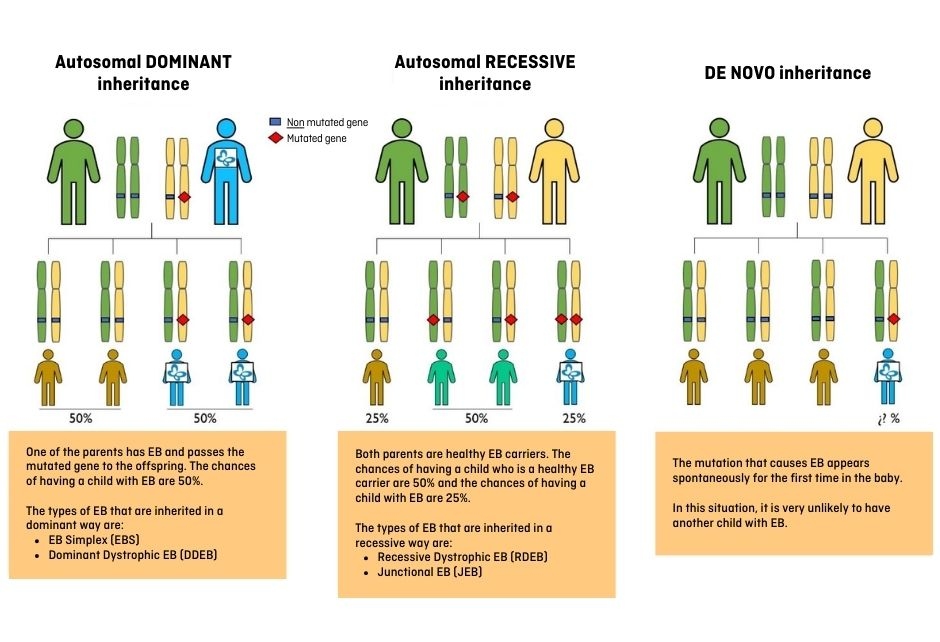Epidermolysis bullosa
3. Inheritance in EB
Epidermolysis bullosa is a genetic disorder, this is, it can be passed from one generation to the next. In this section, we explain how genetic inheritance works and how people inherit EB:
Human cells have 46 chromosomes. The only exception is the reproductive cells (the egg and the sperm) which contain 23 chromosomes.
When an egg and a sperm merge at the beginning of the pregnancy, they constantly divide into cells of 46 chromosomes (23 pairs); therefore, half the chromosomes are inherited from the mother and half from the father. Hence, every human has 2 copies of each of their genes (one copy from the mother and one copy from the father) as the parents contribute 50/50 to the number of genes of their offspring.
When a couple has a baby, the combination of the 4 copies of that gene (2 copies from each parent) are put into play, and we will see the distinctive traits in their offspring depending on the random combination of those 4 copies. For example, let's take brown eye colour (B) vs blue (b). The brown gene copy is dominant (represented in genetics with the capital letter), and it will always prevail over the blue (in lowercase). Therefore, a blue-eyed person will always have two blue copies (bb), but brown-eyed people can have two copies of the brown gene (BB) or one of the brown gene and one of the blue gene (Bb) (Figure 4).

With this example, we can also introduce the concepts of heterozygosity and homozygosity. There is heterozygosity when the two copies of the gene or allele are different (for example, Bb, where there is a copy of the brown allele and one copy of the blue allele). In this case, the information passed on to the offspring will vary depending on the inherited allele (brown or blue). Instead, the genes will be in homozygosity when both alleles are the same (i.e., bb or BB). In this case, the same information will be passed on to the offspring, as the alleles are the same.
In our 23 pairs of chromosomes, one of the pairs is associated with sex and in general terms, depending on which chromosomes we have, we will be biologically defined as women (XX) or men (XY). When speaking of inheritance in EB, we say it is “autosomal dominant” or “autosomal recessive”. The term autosomal refers to the fact that the mutations causing the disease are found in one of the 22 chromosomes that do not define the biological sex of a person or autosomes (Figure 5).
Dominant inheritance
- People with autosomal dominant EB may have inherited the mutation from the mother or the father, having a mutation in just one of the two chromosomes. Therefore, they will have one copy of the healthy gene and one copy of the mutated gene. However, in this case, only one gene copy of is enough to cause the disease.
- It affects both men and women.
- A person with dominant EB has a 50% (1 every 2) chance of having a healthy baby in each pregnancy.
- Most cases of simple epidermolysis bullosa and some cases of dystrophic epidermolysis bullosa are inherited in an autosomal dominant way.
Recessive inheritance
- People with autosomal recessive EB have mutations in both copies of the gene. Both gene copies must be mutated for the person to develop the disease.
- It can affect both men and women.
- Parents are healthy, but each carries a mutated copy of the gene. The "correct" copy is stronger, so none presents the disease. We will only know if the parents are carriers after a child is born with the disease. It is estimated that the incidence of EB mutation carriers is 1/227 people.
- Two carriers of an EB mutation have a 25% (1 every 4) chances of having a baby without any of the mutations and a 50% of having a carrier baby (who will not develop the disease).
- A few cases of simple epidermolysis bullosa, junctural epidermolysis bullosa and most of the dystrophic epidermolysis bullosa are inherited in an autosomal recessive way.
De novo inheritance
Even though it is not very frequent, it is possible that the mutation triggering the disease is not received from the father or the mother. Sometimes mutations appear spontaneously for the first time in the foetus. These are known as de novo mutations.
